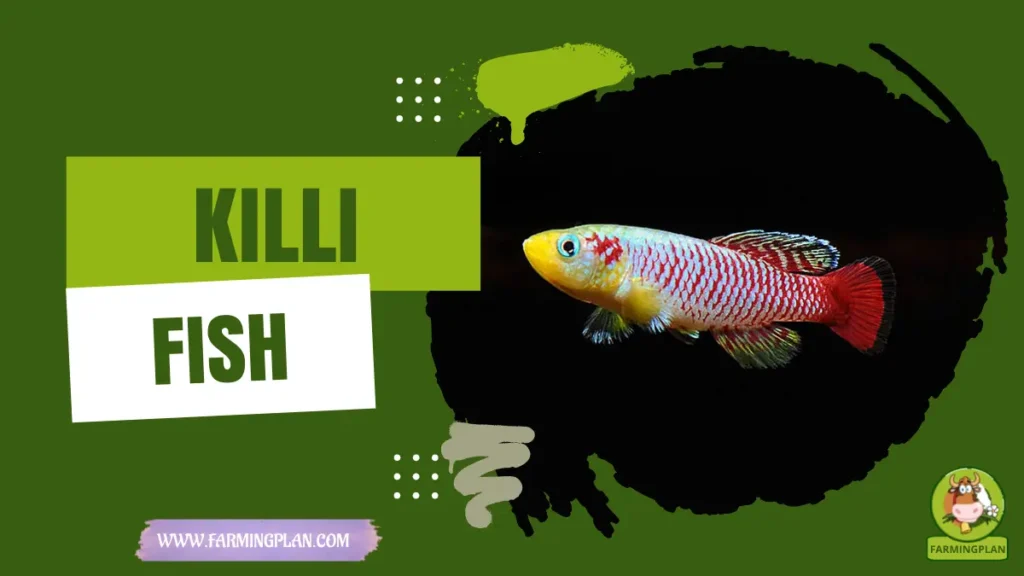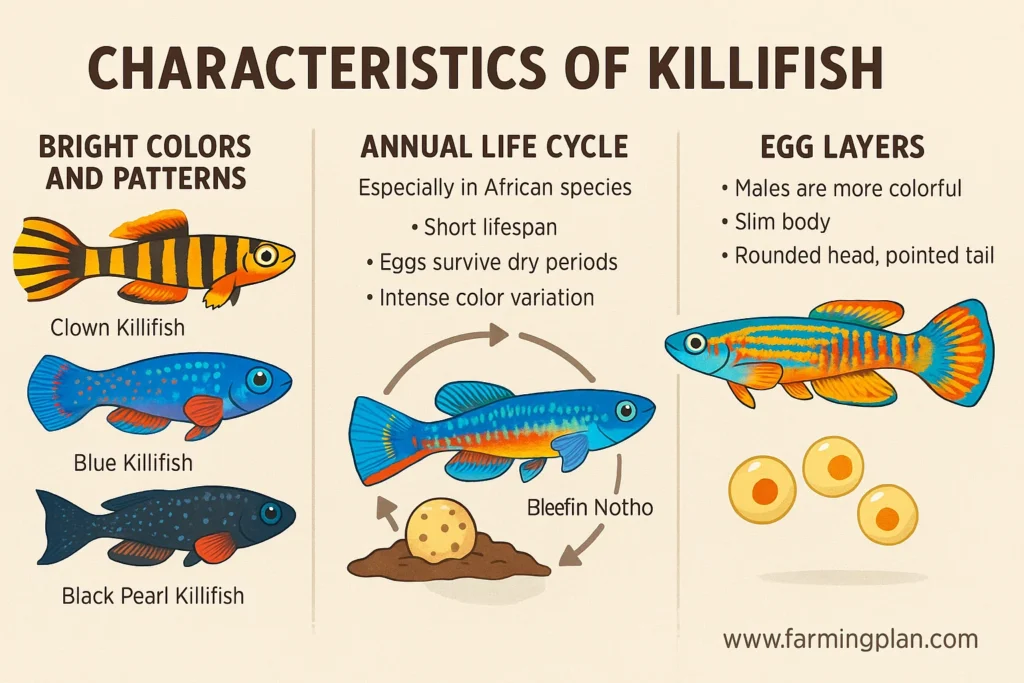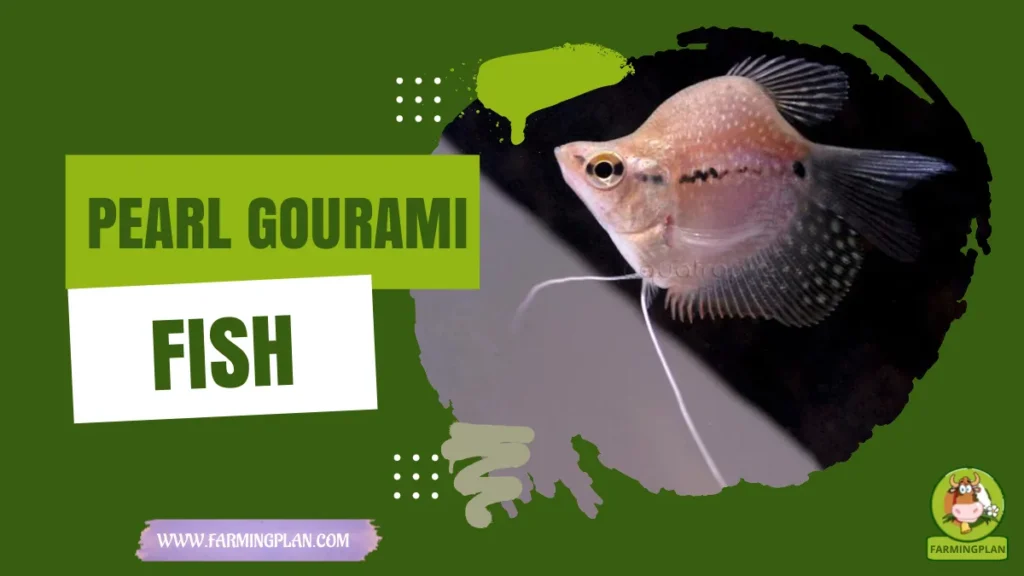Killifish are vibrant, fascinating fish that make a colorful addition to any aquarium. Known for their striking colors and unique life cycle, these fish, such as the clown killifish and African turquoise killifish, are popular among hobbyists. What sets them apart is their ability to survive harsh conditions through diapause, a dormant state during dry seasons. In this article, we’ll cover everything you need to know about killifish, from their history and characteristics to care tips and where to find them for sale.

History & Origin
Killifish have a rich and diverse history rooted in the fresh and brackish waters of Africa, South America, and North America. Many of the most stunning species, like the African turquoise killifish and Nothobranchius furzeri, come from seasonal pools in East and West Africa, where water bodies dry up and refill with the rains. These fish have evolved an amazing adaptation—embryonic diapause—which allows their eggs to survive in dry mud until the next rainy season, a testament to their incredible resilience and adaptability.

The name “killifish” likely comes from the Dutch word kil, meaning creek or small stream. This reflects their natural habitat: shallow, still, or slow-moving waters. Over time, killifish have gained global popularity, not just for their beauty but also for their unique connection to time, environment, and evolution. Today, hobbyists worldwide breed and study species like the American flag , striped , and blue gularis killifish, celebrating their unique traits.
Read More: Platies: The Perfect Colorful Fish for Beginners
Characteristics
Killifish come in a wide range of bright colors, patterns, and fin shapes that make them stand out in any tank. Species like the clown killifish have bold stripes and long, fluttery fins, while the blue killifish and black pearl killifish display shimmering hues that glow under aquarium lights. Their beauty and diversity are sure to captivate any fish enthusiast.

One of the most amazing features of killifish is their annual life cycle, especially in species from Africa. They grow fast, reach sexual maturity in weeks, and lay eggs that can survive months in dry mud. Their short lifespan, often less than a year, is part of what makes them so unique. Some, like the bluefin notho, show intense color variation even within the same species. These fish are egg layers, and males are usually more colorful than females. Their bodies are slim, with rounded heads and pointed tails, allowing them to swim quickly through still waters. Their variety and charm make them a favorite among breeders and fish lovers.
Read More: Mollies Fish: Black and Speckled Yellow Colored Fish
Nature & Temperament
Killifish are generally peaceful and curious, making them great for community aquariums or species tanks. While most are calm, males can show territorial behavior, especially during breeding. It’s best to keep one male with multiple females to reduce stress and avoid fighting. They enjoy exploring plants, rocks, and hiding spots in the tank. Their playful swimming style and bright colors make them fun to watch. Some species, like the Fundulopanchax gardneri, are very active and social, while others are shy and prefer quiet corners.

Killifish adapt well to tank life if the water conditions are right. They prefer calm waters and feel safest in soft, slightly acidic water with cooler temperatures. Their peaceful nature and small size mean they can live with other gentle fish, but avoid pairing them with aggressive or much larger species. They are smart, alert, and even show signs of recognizing their environment. If you’re looking for a fish that’s both beautiful and full of personality, These fish are a great choice.
Read More: Guppy Fish: The Most Beautiful and Reproductive Species
Food & Diet
Killifish love a high-protein diet that keeps them active and healthy. In the wild, they eat small insects, larvae, and crustaceans. In home tanks, they do best with a mix of live, frozen, and dry flake food. Top choices include baby brine shrimp, frozen brine shrimp, daphnia, and bloodworms. These foods mimic what they eat in nature and bring out their colors. You can also feed them flake food or dry pellets, but always go for high-quality options. Feed them small amounts twice a day, and remove uneaten food to keep the water conditions clean. A balanced diet supports their fast development, strong immune system, and bright colors.
“For the brightest colors and healthiest fish, feed a mix of live and frozen foods every week.”
Usage & Purpose
Killifish are mainly kept as ornamental pets thanks to their stunning colors and interesting behaviors. Their small size and peaceful nature make them ideal for community aquariums or dedicated species tanks. Fish lovers enjoy watching their active swimming and flashy displays, especially during breeding. Breeders value killifish for their fast growth and short life cycle, especially annual fish like Nothobranchius furzeri.
These fish reach sexual maturity quickly and are often used in genetic studies and aging research. Scientists study them to understand development, diapause, and even human aging. In some places, larger These species are used as bait for anglers, especially in shallow creeks or marshy areas. However, their main role today is in the home aquarium, where they bring color, curiosity, and charm to fish-keeping enthusiasts around the world.
Special Features
Killifish stand out for more than just their looks. One of their most unique traits is their ability to survive harsh, dry conditions through a process called embryonic diapause. During this time, their eggs pause development and wait for the return of water—an incredible survival skill in seasonal pools across Africa and South America. Species like the African turquoise killifish and Nothobranchius furzeri are known as annual fish because they complete their life cycle in just a few months. Their fast growth and short lifespan make them popular in scientific research, especially in studies on Ageing and Development.
Killifish also show high genetic diversity, which leads to a wide variety of colors and patterns. Some, like the blue gularis and blackfin pearl killifish, have brilliant, iridescent scales, while others like the striped killifish or lampeye fish have glowing eyes or body stripes. These fish also thrive in a wide range of water conditions, from slightly acidic to neutral waters, making them quite adaptable. Their ability to live in temporary bodies of water and their resilience through dry and rainy seasons make them a marvel of nature.
Health Issues & Prevention
Killifish are generally hardy, but like all aquarium fish, they can face some health problems if water quality or diet is poor. The most common issues include fin rot, fungal infections, and parasites like ich. These problems usually show up when tanks are dirty, crowded, or when fish are stressed. To keep your fish healthy, maintain stable water temperatures between 68–75°F, and test water conditions regularly. Always cycle your tank before adding fish, and avoid sudden changes in temperature or pH. Clean the tank weekly and remove any leftover food to prevent harmful bacteria.
Feed them a variety of high-protein foods, and never overfeed. Poor diets can weaken their immune system and shorten their already brief lifespan. When introducing new fish, quarantine them first to avoid spreading disease. If your fish shows signs of illness—like white spots, faded colors, or clamped fins—treat quickly with proper medication and improve water conditions. Healthy fish are active, alert, and colorful.
Pet Owner Care Guide: Step-by-Step
Caring for killifish is simple if you follow the right steps. Here’s a beginner-friendly guide to help you raise happy, healthy fish:
Choose the Right Tank
Start with a species tank or a small community aquarium—10 gallons is great for a pair or trio. Make sure the tank has a secure lid; killifish are skilled jumpers.
Set Up the Tank
Add soft, slightly acidic water, gentle filtration, and live plants or hiding spots. Keep the water temperature between 68–75°F. Use a sponge filter if you’re breeding, to protect the eggs and fry.
Cycle the Tank
Let your tank run for at least 2–4 weeks before adding fish. This allows beneficial bacteria to grow and keeps your water conditions safe.
Pick the Right Species
Choose peaceful species like clown , gardneri , or australe killifish for easy care. Check if your chosen type is annual or non-annual—it affects their care needs.
Feed Them Right
Offer a mix of baby brine shrimp, frozen food, and high-quality flake food. Feed small portions once or twice daily and watch them closely.
Monitor Their Health
Look for bright colors, active swimming, and clear fins. Remove sick fish to a separate tank. Regularly clean the tank and test for ammonia, nitrites, and pH levels.
Breeding Tips
Add spawning mops or peat moss for egg-laying. Remove the eggs if needed and store them in moist peat for diapause (if they’re annual fish). Hatch the eggs by adding water after 2–3 months.
Keep Things Stable
Avoid sudden changes in temperature or water quality. These fish do best in calm, predictable conditions.
Expert Tips & Best Practices
Keeping killifish happy and healthy becomes easier with a few expert tricks. These tips can help you avoid common mistakes and enjoy the full charm of these stunning fish.
Stick to One Male Per Tank (or Group)
Male fish can be territorial, especially in small tanks. Keeping one male with two or more females prevents fighting and stress.
Use Live Plants and Low Lighting
Killifish love shaded spots. Add floating plants and low light to mimic their natural habitat. It also brings out their best colors.
Keep the Lid Tightly Closed
These fish are excellent jumpers. A secure lid saves lives and keeps your tank safe.
Learn Your Species
Each type, from the blue gularis killifish to the American flag killifish, has unique needs. Research their preferred water conditions and behavior before mixing species.
Condition Before Breeding
Feed live foods like brine shrimp for a few days to get them ready to breed. This boosts energy and increases egg production.
Practice Patience with Annual Species
Don’t rush the diapause phase. Store their eggs correctly and wait the full period of time needed before rehydration.
Change Water Weekly
Fresh water keeps disease away. Replace 25–30% of the tank water each week for best results.
Join a Killifish Group
Groups like the American Killifish Association offer advice, trading opportunities, and help from experienced breeders.
Where to Buy
Finding healthy, vibrant killifish is easy if you know where to look. Many online fish stores offer a wide selection, including popular varieties like clown killifish for sale, gardneri killifish for sale, and the striking African turquoise killifish. You can also check local aquarium shops or fish expos for for sale. Always choose sellers with good reviews who specialize in exotic or tropical fish. Look for fish that are active, brightly colored, and swimming well—these are signs of good health.
For rare or wild-caught types like blue gularis killifish or Nothobranchius furzeri, visit breeder forums or join clubs like the American Killifish Association. Members often trade healthy stock and offer tips for care and breeding. When ordering online, make sure the seller offers live arrival guarantees and safe shipping. Ask for details on the fish’s age, diet, and water conditions before buying. Buying from trusted sources ensures your fish live longer, thrive faster, and bring more color to your tank.
FAQ
What are killifish?
Killifish are small, colorful egg-laying fish found in tropical and subtropical waters worldwide. They are known for their vibrant colors and unique breeding behaviors.
How long do killifish live?
Most killifish species have a short lifespan, typically ranging from 1 to 2 years. Annual species may live only a few months, while non-annual species can live up to 5 years in captivity.
What do killifish eat?
Killifish primarily consume live or frozen foods such as brine shrimp, daphnia, and bloodworms. Some species may accept high-quality flake or pellet foods.
Can killifish live with other fish?
Killifish can be kept with other peaceful species like tetras and small catfish. However, males may exhibit territorial behavior, and some species may prey on smaller tank mates.
How do I breed killifish?
Breeding methods vary by species. Annual killifish lay eggs in the substrate, which require a dry incubation period before hatching. Non-annual species lay eggs on plants or other surfaces, which hatch within a few weeks.
Conclusion
Killifish are captivating aquarium fish known for their vibrant colors and unique behaviors. They thrive in species-specific setups with soft, slightly acidic water and subdued lighting. Their diet primarily consists of live or frozen foods, contributing to their health and coloration. While they can coexist with other peaceful species, it’s essential to consider their territorial nature and potential predatory behavior. Breeding killifish requires understanding their specific reproductive methods, whether annual or non-annual. With proper care and attention, killifish can be a delightful addition to your aquarium.


